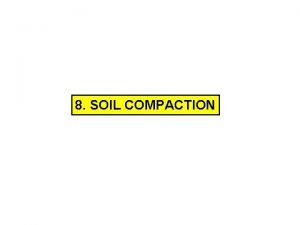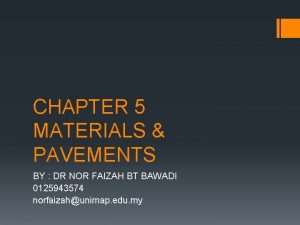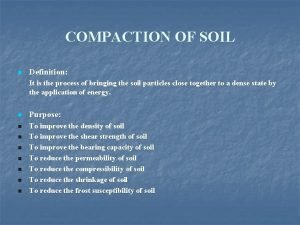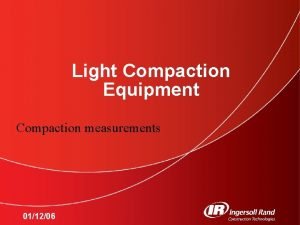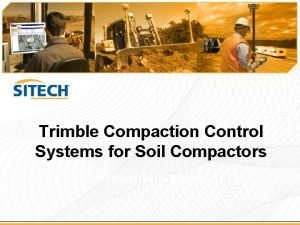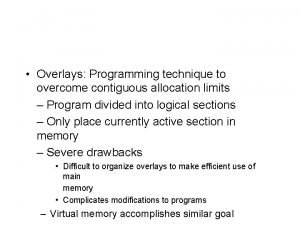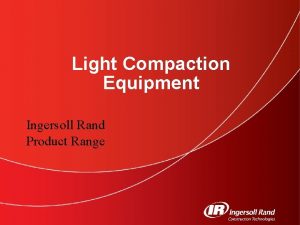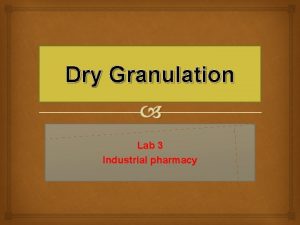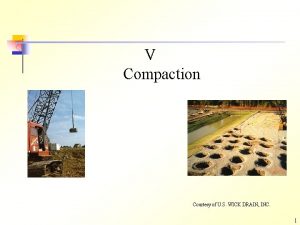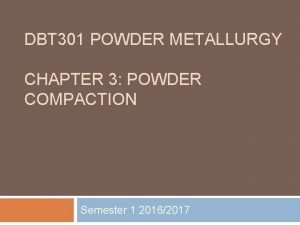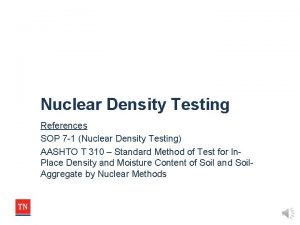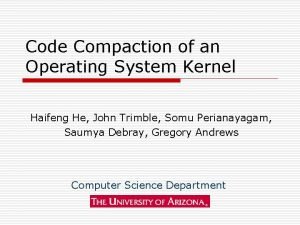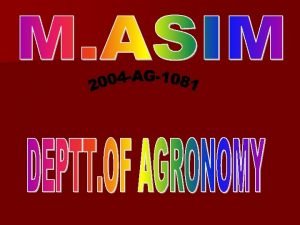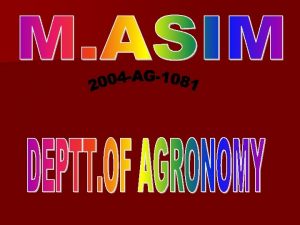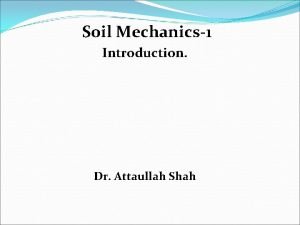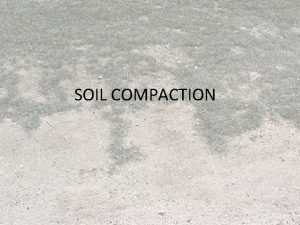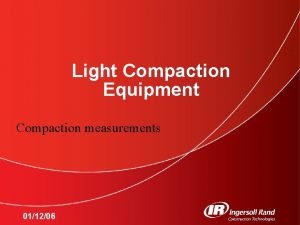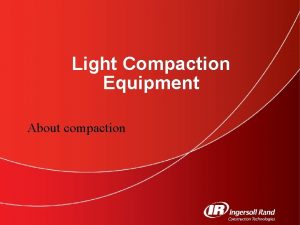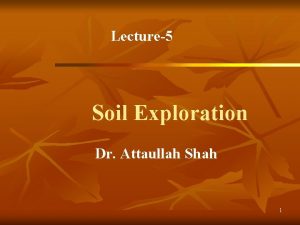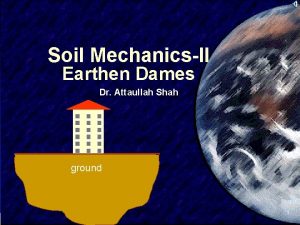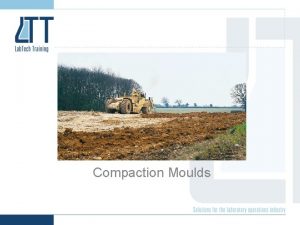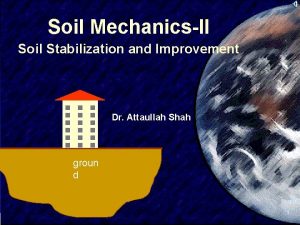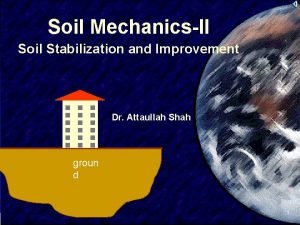Lecture4 Soil Compaction Dr Attaullah Shah 1 Compaction


















- Slides: 18

Lecture-4 Soil Compaction Dr. Attaullah Shah 1

Compaction u The process of bringing the soil particles closer to a dense state by mechanical means. The voids are reduced by expulsion of air and the soil particles are packed together, thereby increasing its unit weight. u There is no substantial change in the volume of water in soil during compaction. u Compaction is done to improve the Engineering properties of soil such as increase of shear, increase the bearing strength, reduce the compressibility of soil, change the soil properties like shrinkage, frost susceptibility and permeability of soils. 2

Uses of soils as fill n In the following cases, soil is used as fill: Backfill of excavation i. e. foundation u To develop made up soils for the building. u As sub grade, sub base, for roads railways and airfields. u As an earthen dam. u To develop site in a difficult terrain, where substantial cutting and filling is required. u 3

Objectives of Compaction n n n Increase the shear strength. Increased bearing capacity for foundation support. Reduce compressibility and smaller settlement of buildings and lesser deformation of earth structures. Reduce permeability, leading to less seepage of water. Improve stability and lower damage due to frost action. Heavy/highway vs. building foundation compaction operations. To reduce the degree of shrinkage and formation of cracks on drying. 4

Soil Compaction means Soil Compaction can be achieved either by static or dynamic loading: 1 - Smooth-wheel rollers 2 - Sheep foot rollers 3 - Rubber-tired rollers 4 - Vibratory Rollers 5 - Vibro flotation 5

Factors affecting Compaction Five factors affecting compaction 1. Physical & chemical properties 2. Moisture content 3. Method of compaction 4. Amount of compactive effort 5. Thickness of layer or “lift” being compacted 6

Moisture Content and Compaction n n The degree of compaction of soil is measured by its unit weight, , and optimum moisture content, wc. By reducing the air voids, more soil can be added to the block. When moisture is added to the block (water content, wc, is increasing) the soil particles will slip more on each other causing more reduction in the total volume, which will result in adding more soil and, hence, the dry density will increase, accordingly. Increasing Wc will increase to certain limit called Optimum moister Content, (OMC) After this limit Increasing Wc will decrease 7

Optimum Moisture Content 8

2. Compaction Efforts. n n The increase in amount of compaction ( energy applied per unit of volume) results in an increase in the maximum dry density and decrease the OMC. In laboratory compaction efforts are applied through: « Two Tests are usually performed in the laboratory to determine the maximum dry unit weight and the OMC. • Standard Proctor Test • Modified Proctor Test « In both the cases the compaction energy is given as The degree of compaction is not directly proportional to compaction efforts and dry density doesn’t increase indefinitely. When the soil is initially loose, the compaction increases the dry density, but further compaction beyond certain point doesn’t increase the density. 9

Effect of Energy on Soil Compaction Increasing compaction energy Dry Density Lower MC and higher dry density Higher Energy V ZA In the field increasing compaction energy = increasing number of passes or reducing lift depth In the lab increasing compaction energy = increasing number of blows Water Content 10

n Field Compaction depends on: Weight of roller u No of passes of roller u n n Relative compaction is given in specification for field compaction, which is the ratio of field dry density to the maximum lab density, whereas the Lab dry density is determined by Standard or Modified AASHTO tests. For example 95% compaction of modified AASHTO dry density 11

Field Soil Compaction Because of the differences between lab and field compaction methods, the maximum dry density in the field may reach 90% to 95%. Dry Density g 95% g d max (OMC) Moisture Content 12

Soil Compaction in the Field: 5 - Sheep foot Roller 1 - Rammers 2 - Vibratory Plates 6 - Dynamic Compaction 3 - Smooth Rollers 4 - Rubber-Tire 13

3. Soil Type: n The following physical properties of soil has direct effect on the compaction efforts: Particle size distribution u Shape of particles u Specific gravity of solids. u Amount and type of clay minerals. u Texture of soils u Maximum dry densities range from 60 lbs per cu ft to 145 for well graded soils. The OMC may range from 5% for granular material to about 35% for plastic material. u 14

4. Compaction method n Compaction efforts may be provided by: Kneading ( Using punching device) u Dynamic ( Rollers) u Static action ( Mechanical jacks) u • 5. Admixtures: Lime Cement Bitumen Industrial wastes 15

7. Processing amount u n By thorough mixing of moisture in the soil, higher density is achieved. 8. Energy Distribution: u Uniform distribution of compaction loads lead to better compaction and higher dry density. 16

Soil Compaction in the Lab: 1 - Standard Proctor Test 2 - Modified Proctor Test Standard Proctor Test Modified Proctor Test 17

Checking Soil Density in the Field: 1 - Sand Cone (ASTM D 1556 -90) A small hole (6" x 6" deep) is dug in the compacted material to be tested. The soil is removed and weighed, then dried and weighed again to determine its moisture content. A soil's moisture is figured as a percentage. The specific volume of the hole is determined by filling it with calibrated dry sand from a jar and cone device. The dry weight of the soil removed is divided by the volume of sand needed to fill the hole. This gives us the density of the compacted soil in lbs per cubic foot. This density is compared to the maximum Proctor density obtained earlier, which gives us the relative density of the soil that was just compacted. 2 - Balloon Dens meter The same as the sand cone, except a rubber balloon is used to determine the volume of the hole 3 - Nuclear Density (ASTM D 2292 -91) Nuclear Density meters are a quick and fairly accurate way of determining density and moisture content. The meter uses a radioactive isotope source (Cesium 137) at the soil surface (backscatter) or from a probe placed into the soil (direct transmission). The isotope source gives off photons (usually Gamma rays) which radiate back to the mater's detectors on the bottom of the unit. Dense soil absorbs more radiation than loose soil and the readings reflect overall density. Water content (ASTM D 3017) can also be read, all within a few 18 minutes.
 Dr attaullah tutorial
Dr attaullah tutorial Astm 698
Astm 698 Soil structure ppt
Soil structure ppt Soil compaction
Soil compaction Define compaction of soil
Define compaction of soil What are the four spheres of the earth
What are the four spheres of the earth Living soil vs dead soil
Living soil vs dead soil Light compaction equipment
Light compaction equipment Trimble
Trimble Levels of compaction in dna
Levels of compaction in dna Coalescing holes in operating system
Coalescing holes in operating system Light compaction equipment
Light compaction equipment Igneous rock to metamorphic rock
Igneous rock to metamorphic rock Nucloesome
Nucloesome Slugging dry granulation
Slugging dry granulation Us wick drain
Us wick drain Isostatic pressing
Isostatic pressing Nuclear compaction test
Nuclear compaction test Compaction in operating system
Compaction in operating system

